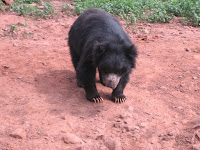The rock shelters and paintings of Bhimbetka, 41km south of Bhopal, contain some of the world's oldest Stone Age paintings. They were discovered in 1957-58 by Dr Vishnu Shridhar Wakanker, around 9,000 years after the artists put brush to rock.

The caves were very impressive, with one towering high and having a tunnel running all the way through it. It would've been perfect for sports climbing! The paintings were beautiful, with the oldest painted white. As with television, colour came much later. Our favourite painting was the bison chasing the distressed hunter.



On the way to the caves, we met some nice kids. They were on their way home from school and were keen to chat to us in English. We also met a pleasant group of men at the caves. We were really pleased to meet such nice and normal people who were genuinely curious and friendly. We protested that we weren't celebrities but the men insisted on taking our photo. The expressions on their faces range from dumbstruck (far left) to pride (far right).

On the walk back to the main road we were accompanied by five cows. Once we left them, we came across four water buffalo doing what they do best in the heat of the late afternoon. Later on, it rained for the first time since we left Mumbai. We have been so lucky that we've managed to get some beautiful weather even though it's the monsoon season. Glad the gamble with the timing of our visit to India has worked out ok so far.


Our observation today is that there are very few women around on the buses, at sights and on the streets, with the ratio being somewhere around 90% men to 10% women.
We're feeling slightly less frazzled today than we did yesterday. We're looking forward to our next destination, Gwalior, which is home to an impressive fort.































